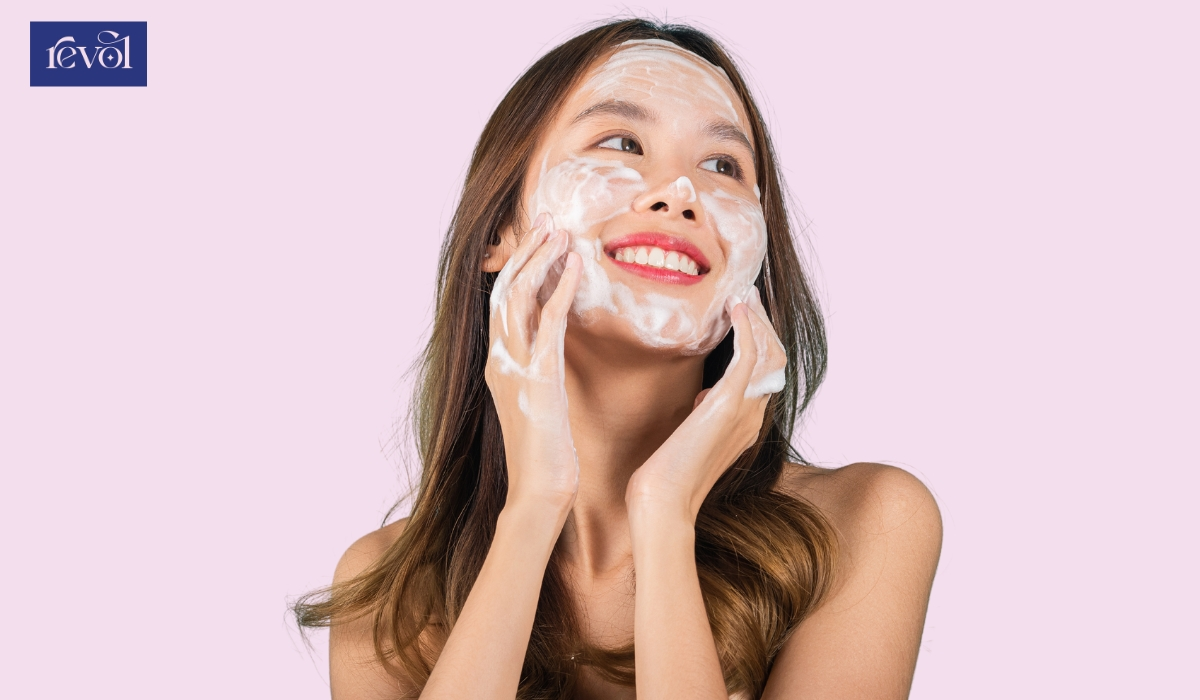Blog
Perfect Your Skincare: How to Use Face Wash

Do you know how to use face wash correctly and which one is right for your skin? There are so many products and opinions out there, but finding the right face wash routine can make a huge difference to your skin. No matter if you have oily, dry, or sensitive skin, knowing the proper method of washing your face can help you achieve healthy skin. Now, let’s get into the details of face wash and how you can get the best out of your skin.
Understanding Your Skin Type
Choosing the right face wash starts with knowing your skin type. The texture and appearance of your skin can vary, affecting how products interact with it.
Identifying Your Skin Type
Curious to know how to determine your skin type? Begin by looking at the skin in its normal condition. What does the hair and scalp look and feel like in the morning before applying the products?
If it looks shiny, then you are most probably struggling with oily skin. Flaky skin indicates dry skin, while if the skin is both oily in some areas and dry in others, then it is considered to be combination skin. Skin that is sensitive becomes irritated or feels tight and may react to certain products by becoming red.
Choosing the Right Face Wash
Once you know your skin type, look for face washes tailored to your needs:
- Oily Skin: Opt for gel or foaming cleansers containing salicylic acid to control oil production. For oily skin, there are numerous options, but the most recommended is Clarity-Revive Face Wash.
- Dry Skin: Cream-based cleansers help add moisture without stripping your skin, such as Nourish- Silk Face Wash.
- Sensitive Skin: Look for dermatologist-tested and fragrance-free products.
- Combination Skin: Gentle, balanced cleansers can help manage fluctuating oil levels.
Step-by-Step Guide: How to Use Face Wash
Getting the most out of your face wash requires the proper techniques. Follow these steps for optimal results.
1. Preparation Before Washing
First of all, it is necessary to wash the face and take off any makeup. This will enable your face wash to work as expected. If you have to remove makeup, use a good makeup remover, and when washing your face, use warm water, as it is mild and effectively softens the skin and the dirt.
2. The Washing Technique
Begin with a small amount of face wash, about the size of a coin, in your palms. Suds (foam) it up and rub it in circular motions on your skin. Concentrate on areas that are most oily, such as the forehead, the area around the nose, and the chin. It is recommended that you spend at least 30 seconds to a minute massaging your face wash in to allow active ingredients to work.
3. Rinsing and Drying
Finally, wash your face with lukewarm water and make sure that you wash off all the soap. Do not use hot water, as this will remove the skin’s natural oils. Use a clean, soft towel to pat your face dry. Just remember, it is better to pat the skin instead of rubbing it to avoid skin irritation.
Common Mistakes to Avoid
It is important to know that even those who are most experienced in skincare can make mistakes. Here is how to avoid them.
Over-Washing
It is also important not to wash your face too often because this may lead to the removal of the skin’s natural oils, which may lead to dry skin or skin that produces too much oil. When you clean your face too much, your skin might react by:
- Your skin gets dry, tight, or irritated.
- You get more breakouts because your skin is making too much oil.
- Your skin turns red or becomes sensitive.
Keep in mind that even if your skin is oily, you need to keep things balanced. It is recommended to wash only twice a day, in the morning and before going to bed.
Using Hot Water
While hot water is comfortable for the skin, it is destructive to the skin’s outermost layer. Lukewarm water is the best choice for maintaining your skin’s balance.
Adjusting for Skin Conditions
You may need to change your facial wash based on your specific skin needs or circumstances:
- Acne-Prone Skin: People with acne should wash their face twice . Over-washing will not help with acne and can irritate your skin. Choose a cleaner that contains ingredients such as benzoyl peroxide, glycolic acid, or tea tree oil to manage excess oil and reduce breakouts.
- Rosacea or Eczema: As these conditions worsen, you may need to cut back on washing your face once a day. It is best to do this at night to minimize irritation. Always consult a dermatologist for the advice you need during these times.
- Post-exercise: Do you sweat a lot during exercise or outdoor activities? It is advisable to wash your face afterwards to remove sweat and germs. This additional cleanse does not add to your daily limit and helps prevent blockages and possible breakdowns.
- Seasonal Changes: You may need to change your face-washing routine as seasons shift. When winter comes and skin gets drier, you could skip washing in the morning if your skin feels dry. On the other hand, summer heat can make you sweat more and produce more oil, so washing twice a day can help keep your skin clean.
- Menopausal Skin: When women approach menopause, their estrogen levels drop. This makes their skin dry and irritated. For these women, experts suggest washing faces at least once and twice if possible. For this purpose, a mild cleaner should be used.
Remember, your face wash is just as important as your face washing process. Strong cleansers can weaken your skin’s natural defense, resulting in dryness, irritation, and other skin-related issues. Use gentle, pH-balanced cleansers that won’t strip away your skin’s natural oils.
Ceramides, glycerin, or hyaluronic acid clean dry skin. For those with oily skin, you might be wondering, Is hyaluronic acid good for oily skin? For oily skin or acne, use light, oil-free cleansers to control extra oil and avoid drying the skin. Remember, oily skin needs moisture to balance out and prevent excessive oil production.
Aftercare: Next Steps in Your Skincare Routine
Completing your skincare routine doesn’t end after washing. Let’s talk about what comes next.
Moisturizing
After cleansing, always use a moisturizer to lock in hydration. Lightweight gels are ideal for oily skin, while thicker creams cater to dry skin types. Moisturizing replenishes your skin’s moisture and creates a protective barrier.
Using Toners and Serums
Add a toner to your skin care routine to restore the skin’s pH and wash off any remaining dirt. Use serums next, especially those with antioxidant or moisturizing properties, if you have issues like aging or dry skin.
Targeted Treatments
Once you’ve laid this base with your facial wash and basic skincare routine, you’ll find that adding in some focused treatments may help with those targeted issues and really drive your results. These treatments are developed for specific skin concerns, such as acne and hyperpigmentation, fine lines, dullness, and others. Here’s how to incorporate them into your routine effectively:
1. Identify Your Skin Concerns
Knowing what your main skin concerns are before any kind of targeted treatment is key. Whether you have acne, dark spots, or even wrinkles, it becomes very essential to understand your needs in choosing products accordingly.
2. Choose the Right Products
- Acne Treatments: Find ingredients that are salicylic acid, benzoyl peroxide, or retinoids in content for unclogging pores and reducing inflammation.
- Hyperpigmentation: Ingredients such as vitamin C, niacinamide, and alpha arbutin not only help in skin brightening but also help reduce dark spots caused by hyperpigmentation.
- Anti-Aging: Some of the products containing retinoids, peptides, and hyaluronic acid do have anti-aging properties, making it easier to smooth out thin lines and improve skin texture.
- Hydration: For dry or sensitive skin, utilize treatments containing hyaluronic acid, glycerin, or ceramides to enhance the content of water within the skin.
3. Layering and Application
- Consistency: Apply targeted treatments after cleansing and before moisturizing. This ensures that the active ingredients are effectively absorbed.
- Frequency: Always follow the usage instructions on the product. Some treatments may be used daily, while others may be recommended a few times a week to avoid irritation.
4. Monitor and Adjust
Keep a record of how your skin responds to the treatments. If irritation is experienced or if the desired results are not achieved, then frequency may need to be lowered or products changed. Other times, it is just trial and error to find what really works for your skin.
5. Complementary Products
Couple these with some supportive products, like sunscreens and moisturizers, to keep that skin barrier healthy and balanced. Sunscreen, in particular, is very important, for many treatments will make your skin more sun-sensitive.
Thoughtfully add some targeted treatments into your skincare routine to address certain skin concerns and improve the overall regimen. Be patient, and remember that patience and consistency are the best ways to go toward achieving and maintaining optimal results.
Conclusion
The proper face wash with suitable products can change the whole scenario of your skin care routine. Therefore, knowing your skin type and washing your face according to a proper regimen is a perfect start for better skin. Begin today and let every washing be a process of attaining clear skin. Your skin will surely love you for it.
Learning how to use face washes is one of those things that can turn your skincare routine into a true art and make your skin shine with brightness. In this way, knowing the type of your skin and applying the proper approach, you create all the necessary conditions for a healthy skin. The most important thing is to maintain a schedule, make changes if necessary, and your skin will reward you with a healthy and well-toned glow.
Feeling like it is time to up your skincare game? Find a variety of face washes and skin care products that are specifically designed for your skin type at Revol.pk. Begin your journey to perfect skin now!
Love what you’re learning about skincare? Feel free to share this article with friends who might benefit from a refreshed face wash routine. And if you have any tips or questions about face washing, drop them in the comments below!




